+ Open data
Open data
- Basic information
Basic information
| Entry | Database: PDB / ID: 6odf | |||||||||
|---|---|---|---|---|---|---|---|---|---|---|
| Title | EEEV glycoproteins bound with heparan sulfate | |||||||||
 Components Components |
| |||||||||
 Keywords Keywords | VIRUS / EEEV | |||||||||
| Function / homology |  Function and homology information Function and homology informationtogavirin / T=4 icosahedral viral capsid / symbiont-mediated suppression of host toll-like receptor signaling pathway / host cell cytoplasm / symbiont-mediated suppression of host gene expression / serine-type endopeptidase activity / fusion of virus membrane with host endosome membrane / symbiont entry into host cell / virion attachment to host cell / host cell nucleus ...togavirin / T=4 icosahedral viral capsid / symbiont-mediated suppression of host toll-like receptor signaling pathway / host cell cytoplasm / symbiont-mediated suppression of host gene expression / serine-type endopeptidase activity / fusion of virus membrane with host endosome membrane / symbiont entry into host cell / virion attachment to host cell / host cell nucleus / host cell plasma membrane / virion membrane / structural molecule activity / proteolysis / RNA binding / membrane Similarity search - Function | |||||||||
| Biological species |   Eastern equine encephalitis virus Eastern equine encephalitis virus | |||||||||
| Method | ELECTRON MICROSCOPY / single particle reconstruction / cryo EM / Resolution: 5.8 Å | |||||||||
 Authors Authors | Rossmann, M.G. / Chen, C.L. | |||||||||
| Funding support |  United States, 1items United States, 1items
| |||||||||
 Citation Citation |  Journal: Proc Natl Acad Sci U S A / Year: 2020 Journal: Proc Natl Acad Sci U S A / Year: 2020Title: Cryo-EM structure of eastern equine encephalitis virus in complex with heparan sulfate analogues. Authors: Chun-Liang Chen / S Saif Hasan / Thomas Klose / Yingyuan Sun / Geeta Buda / Chengqun Sun / William B Klimstra / Michael G Rossmann /  Abstract: Eastern equine encephalitis virus (EEEV), a mosquito-borne icosahedral alphavirus found mainly in North America, causes human and equine neurotropic infections. EEEV neurovirulence is influenced by ...Eastern equine encephalitis virus (EEEV), a mosquito-borne icosahedral alphavirus found mainly in North America, causes human and equine neurotropic infections. EEEV neurovirulence is influenced by the interaction of the viral envelope protein E2 with heparan sulfate (HS) proteoglycans from the host's plasma membrane during virus entry. Here, we present a 5.8-Å cryoelectron microscopy (cryo-EM) structure of EEEV complexed with the HS analog heparin. "Peripheral" HS binding sites were found to be associated with the base of each of the E2 glycoproteins that form the 60 quasi-threefold spikes (q3) and the 20 sites associated with the icosahedral threefold axes (i3). In addition, there is one HS site at the vertex of each q3 and i3 spike (the "axial" sites). Both the axial and peripheral sites are surrounded by basic residues, suggesting an electrostatic mechanism for HS binding. These residues are highly conserved among EEEV strains, and therefore a change in these residues might be linked to EEEV neurovirulence. | |||||||||
| History |
|
- Structure visualization
Structure visualization
| Movie |
 Movie viewer Movie viewer |
|---|---|
| Structure viewer | Molecule:  Molmil Molmil Jmol/JSmol Jmol/JSmol |
- Downloads & links
Downloads & links
- Download
Download
| PDBx/mmCIF format |  6odf.cif.gz 6odf.cif.gz | 655 KB | Display |  PDBx/mmCIF format PDBx/mmCIF format |
|---|---|---|---|---|
| PDB format |  pdb6odf.ent.gz pdb6odf.ent.gz | 536.8 KB | Display |  PDB format PDB format |
| PDBx/mmJSON format |  6odf.json.gz 6odf.json.gz | Tree view |  PDBx/mmJSON format PDBx/mmJSON format | |
| Others |  Other downloads Other downloads |
-Validation report
| Summary document |  6odf_validation.pdf.gz 6odf_validation.pdf.gz | 1.5 MB | Display |  wwPDB validaton report wwPDB validaton report |
|---|---|---|---|---|
| Full document |  6odf_full_validation.pdf.gz 6odf_full_validation.pdf.gz | 1.5 MB | Display | |
| Data in XML |  6odf_validation.xml.gz 6odf_validation.xml.gz | 101.9 KB | Display | |
| Data in CIF |  6odf_validation.cif.gz 6odf_validation.cif.gz | 157.8 KB | Display | |
| Arichive directory |  https://data.pdbj.org/pub/pdb/validation_reports/od/6odf https://data.pdbj.org/pub/pdb/validation_reports/od/6odf ftp://data.pdbj.org/pub/pdb/validation_reports/od/6odf ftp://data.pdbj.org/pub/pdb/validation_reports/od/6odf | HTTPS FTP |
-Related structure data
| Related structure data |  20019MC M: map data used to model this data C: citing same article ( |
|---|---|
| Similar structure data |
- Links
Links
- Assembly
Assembly
| Deposited unit | 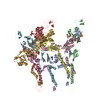
|
|---|---|
| 1 | x 60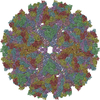
|
| 2 |
|
| 3 | x 5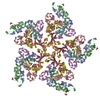
|
| 4 | x 6
|
| 5 | 
|
| Symmetry | Point symmetry: (Schoenflies symbol: I (icosahedral)) |
- Components
Components
| #1: Protein | Mass: 47938.141 Da / Num. of mol.: 4 / Fragment: UNP residues 802-1242 Source method: isolated from a genetically manipulated source Source: (gene. exp.)   Eastern equine encephalitis virus / Cell line (production host): BHK-15 / Production host: Eastern equine encephalitis virus / Cell line (production host): BHK-15 / Production host:  Cricetinae gen. sp. (mammal) Cricetinae gen. sp. (mammal)References: UniProt: E9KXM2, UniProt: Q4QXJ7*PLUS, togavirin #2: Protein | Mass: 47046.953 Da / Num. of mol.: 4 / Fragment: UNP residues 325-744 Source method: isolated from a genetically manipulated source Source: (gene. exp.)   Eastern equine encephalitis virus / Cell line (production host): BHK-15 / Production host: Eastern equine encephalitis virus / Cell line (production host): BHK-15 / Production host:  Cricetinae gen. sp. (mammal) Cricetinae gen. sp. (mammal)References: UniProt: E9KXL2, UniProt: Q4QXJ7*PLUS, togavirin #3: Polysaccharide | 2-O-sulfo-beta-L-galactopyranuronic acid-(1-4)-[(2R,3R,4R,5R,6R)-2,4,5-trihydroxy-6-(sulfooxy) ...2-O-sulfo-beta-L-galactopyranuronic acid-(1-4)-[(2R,3R,4R,5R,6R)-2,4,5-trihydroxy-6-(sulfooxy)tetrahydro-2H-pyran-3-yl]sulfamic acid Type: oligosaccharide / Mass: 581.459 Da / Num. of mol.: 6 Source method: isolated from a genetically manipulated source Has protein modification | Y | |
|---|
-Experimental details
-Experiment
| Experiment | Method: ELECTRON MICROSCOPY |
|---|---|
| EM experiment | Aggregation state: PARTICLE / 3D reconstruction method: single particle reconstruction |
- Sample preparation
Sample preparation
| Component | Name: EEEV glycoproteins bound with heparan / Type: VIRUS / Entity ID: #1-#2 / Source: RECOMBINANT | ||||||||||||||||||||
|---|---|---|---|---|---|---|---|---|---|---|---|---|---|---|---|---|---|---|---|---|---|
| Molecular weight | Experimental value: NO | ||||||||||||||||||||
| Source (natural) | Organism:   Eastern equine encephalitis virus Eastern equine encephalitis virus | ||||||||||||||||||||
| Source (recombinant) | Organism:  Cricetinae gen. sp. (mammal) / Cell: BHK-15 Cricetinae gen. sp. (mammal) / Cell: BHK-15 | ||||||||||||||||||||
| Details of virus | Empty: YES / Enveloped: NO / Isolate: STRAIN / Type: VIRION | ||||||||||||||||||||
| Buffer solution | pH: 8 / Details: Tris | ||||||||||||||||||||
| Buffer component |
| ||||||||||||||||||||
| Specimen | Conc.: 0.5 mg/ml / Embedding applied: NO / Shadowing applied: NO / Staining applied: NO / Vitrification applied: YES | ||||||||||||||||||||
| Specimen support | Grid material: COPPER / Grid mesh size: 400 divisions/in. | ||||||||||||||||||||
| Vitrification | Instrument: GATAN CRYOPLUNGE 3 / Cryogen name: ETHANE / Humidity: 80 % / Chamber temperature: 298 K |
- Electron microscopy imaging
Electron microscopy imaging
| Experimental equipment |  Model: Titan Krios / Image courtesy: FEI Company |
|---|---|
| Microscopy | Model: FEI TITAN KRIOS |
| Electron gun | Electron source:  FIELD EMISSION GUN / Accelerating voltage: 300 kV / Illumination mode: FLOOD BEAM FIELD EMISSION GUN / Accelerating voltage: 300 kV / Illumination mode: FLOOD BEAM |
| Electron lens | Mode: BRIGHT FIELD / Alignment procedure: COMA FREE |
| Specimen holder | Cryogen: NITROGEN / Specimen holder model: FEI TITAN KRIOS AUTOGRID HOLDER |
| Image recording | Electron dose: 32 e/Å2 / Detector mode: SUPER-RESOLUTION / Film or detector model: GATAN K2 SUMMIT (4k x 4k) |
- Processing
Processing
| EM software |
| ||||||||||||||||||||||||||||||||
|---|---|---|---|---|---|---|---|---|---|---|---|---|---|---|---|---|---|---|---|---|---|---|---|---|---|---|---|---|---|---|---|---|---|
| CTF correction | Type: PHASE FLIPPING AND AMPLITUDE CORRECTION | ||||||||||||||||||||||||||||||||
| Particle selection | Num. of particles selected: 17022 | ||||||||||||||||||||||||||||||||
| Symmetry | Point symmetry: I (icosahedral) | ||||||||||||||||||||||||||||||||
| 3D reconstruction | Resolution: 5.8 Å / Resolution method: FSC 0.143 CUT-OFF / Num. of particles: 17022 / Algorithm: FOURIER SPACE / Symmetry type: POINT | ||||||||||||||||||||||||||||||||
| Atomic model building | Protocol: RIGID BODY FIT / Space: REAL | ||||||||||||||||||||||||||||||||
| Atomic model building | PDB-ID: 6MX4 Accession code: 6MX4 / Source name: PDB / Type: experimental model |
 Movie
Movie Controller
Controller



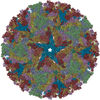
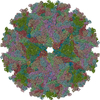

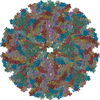


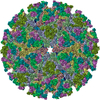
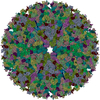


 PDBj
PDBj



